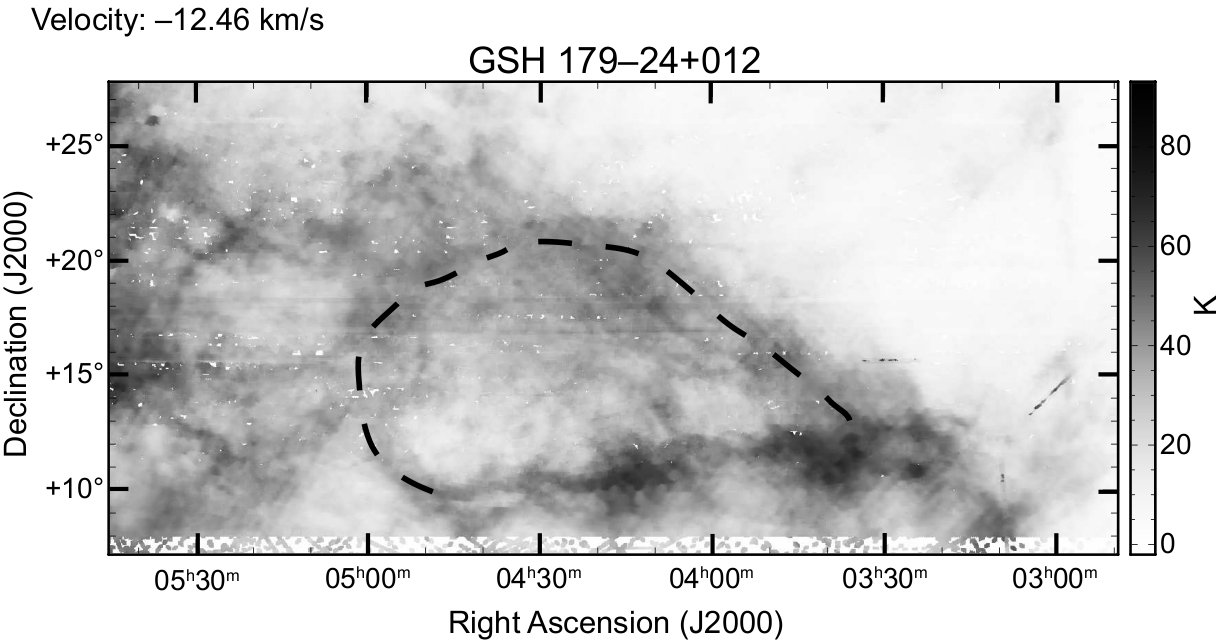Study of Interstellar Shells in our Galaxy
Introduction
The interstellar medium (ISM) is low-density material (mostly gas)
that lies between the stars. Stars forms through the mixing of this
gas. When a star dies it replenishes the gas with new elements that are
heavier than the original hydrogen and helium. New stars and planetary
systems form from this enriched material, so "We are made of Star Stuff",
as Carl Sagan says. I've also heard some stay "We're made of thermonuclear
waste".
Stellar winds and supernovae (exploding stars) send material out into
the surrounding non-uniform ISM, often blowing a bubble. The ambient
gas is disturbed and forms irregular shells. Young shells are typically
filled with hot (about 1 million K) X-ray emitting gas, surrounded by
a shell of cooler neutral material, with an interface layer of ionized
material at intermediate temperatures.

Neutral Hydrogen (HI) image of an interstellar shell.
(SETHI Shell Catalog)
Research Projects
Dr. Sallmen and undergraduate students at UW-La Crosse are studying
interstellar shells within our own Milky Way Galaxy. Overall, the main
goal is to
increase our sample of neutral hydrogen shells that have been
studied in detail, in order to enhance our understanding of the processes
whereby these objects interact with the ambient ISM. An adequate sample of
well-studied neutral shells is essential for testing competing models of
supershell formation, as well as for understanding the processes whereby
energy from supernovae and stellar winds affect the structure of the ISM
as a whole. This research will improve the number of shells identified for
study, the number of shells with detailed optical narrow-band imaging, and
the number of shells with multi-wavelength emission comparisons.
In particular, the following projects meet these goals:
- Searching for neutral hydrogen (HI) shells using high-resolution 21-cm
radio surveys taken with the Arecibo telescope. These will help identify
previously neglected shells that are suitable for followup observations.
The radio data allow us to estimate the distance, physical size, expansion
velocity, and energy requirements for a subset of the shells.
- The search is complete for the
SETHI database
of radio data (originally taken for the
SETI@home project).
- The SETHI Shell Catalog is available here. (August 6, 2014 copy)
- The GALFA-HI Survey
data complement the sky coverage of the SETHI data, but at even higher
resolution and with improved calibration. The search process has just
begun for these data.
- Imaging shells in the Interstellar Medium using the WIYN 0.9-m telescope at
Kitt Peak National Observatory
will provide high angular resolution H-alpha maps of the ionized hydrogen
in these shells.
- Detailed comparison of the cool neutral hydrogen (using SETHI data)
warm ionized hydrogen (using H-alpha images), and hot material (using
archival X-ray images),allowing us to use multi-wavelength analysis to
determine the properties of the interacting gas.
- Future ground-based spectroscopic absorption-line studies of the shells
will allow us to determine more accurate distances to the absorption components
of the shells. With this method, we can study the velocity structure of the
approaching and receding shell walls for both neutral and ionized gas.
These data will also allow us to investigate the physical state of
the gas in these expanding shells. The improved distances will allow
us to improve our estimate the shell sizes, which are important input
parameters in the energetic considerations of all theoretical models of
bubble formation and evolution.
This research complements other studies of the ISM and interstellar shells
previously undertaken by Dr. Sallmen. These include:
- Ground-based spectroscopic absorption-line studies of interstellar
shells (Orion-Eridanus superbubble, Shajn 147 SNR, IC 443 SNR,
Cygnus Loop SNR, Local Interstellar Chimney)
- Investigations of hot gas in the ISM using NASA's Far Ultraviolet Spectroscopic Explorer
satellite.
- Data reduction and analysis of archival radio pulsar data (from NRAO's
85-foot telescope
in Green Bank, WV) on the Vela pulsar to investigate the properties of the ISM
and the Vela Supernova Remnant.
Online ISM Introductions
Funding Acknowledgements
This research has been funded in part by:

